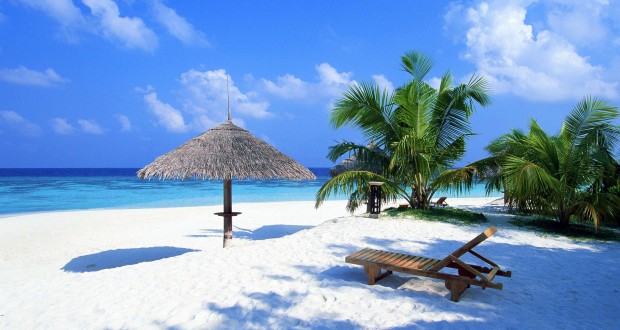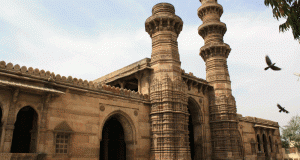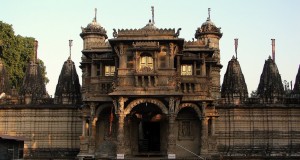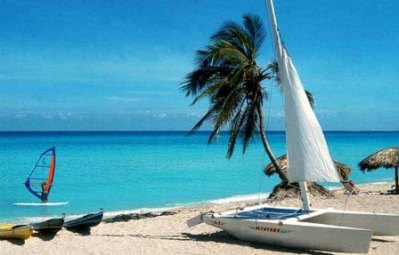 sheltered palm-fronted cove, with enchanting views of Marmagao Harbour and Zuari river estuary, this is another beautiful sunset spot. The sophisticated 0′- Pescador restaurant and exclusive Hotel Cidade de Goa are both located here.Driving into the cathedral ghost-town of Old Goa (9 km: 5 1/2 miles from Panjim), you’ll immediately detect the strong Latin influence. The priests of Rome were the real rulers here, not the Portuguese conquistadors, and the religious arrogance of the old conquerors is reflected in the grandiose complex of churches, monasteries and convents, many rivalling in size and scale the great cathedrals of Renaissance Europe. The Portuguese arrived here in 1510, bearing a sword in one hand, a crucifix in the other. Goa Veiha , as Old Goa was then called, became a city of great splendour and power, dominated by the huge ecclesiastical buildings which replaced the old mosques and temples of former Muslim rulers. Then came a series of devastating plagues (1543, 1635 and 1735), decimating 80% of the population. In 1835 Old Goa was abandoned, and the administrative capital transferred to Panjim. Today, it is just a small village built round the
sheltered palm-fronted cove, with enchanting views of Marmagao Harbour and Zuari river estuary, this is another beautiful sunset spot. The sophisticated 0′- Pescador restaurant and exclusive Hotel Cidade de Goa are both located here.Driving into the cathedral ghost-town of Old Goa (9 km: 5 1/2 miles from Panjim), you’ll immediately detect the strong Latin influence. The priests of Rome were the real rulers here, not the Portuguese conquistadors, and the religious arrogance of the old conquerors is reflected in the grandiose complex of churches, monasteries and convents, many rivalling in size and scale the great cathedrals of Renaissance Europe. The Portuguese arrived here in 1510, bearing a sword in one hand, a crucifix in the other. Goa Veiha , as Old Goa was then called, became a city of great splendour and power, dominated by the huge ecclesiastical buildings which replaced the old mosques and temples of former Muslim rulers. Then came a series of devastating plagues (1543, 1635 and 1735), decimating 80% of the population. In 1835 Old Goa was abandoned, and the administrative capital transferred to Panjim. Today, it is just a small village built round the 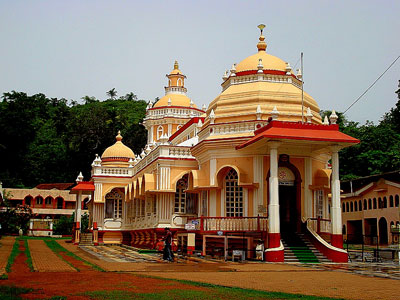 ruined hulks of huge convents and churches dedicated to the zeal of Christianity. At present, only 6 of the town’s original 14 churches remain in good condition, their red laterite structures eroded by centuries of wind and rain. They’re a complete contrast to Hindu temples and shrines, though some find these haughty Catholic structures uncomfortably unlike India, much more reminiscent of Lisbon or Rome. If returning for a longer look, come in by local bus from either Panjim (10 minutes) or Margao (30 minutes). Old Goa really should be appreciated at leisure—one can spend hours wandering round the vast, deserted cloisters and corridors of these decaying old buildings. The Archaeological Survey of India has published an excellent 52-page guide, Old Goa, which is available locally and at their New Delhi office.On tour, you’ll first visit the Basilica of Born Jesus (‘good Jesus’), Goa’s most copular and famous church. Built between 1594 and 1604, the rather dim interior is enlivener by the gilded baroque high altar, with elaborate screens and
ruined hulks of huge convents and churches dedicated to the zeal of Christianity. At present, only 6 of the town’s original 14 churches remain in good condition, their red laterite structures eroded by centuries of wind and rain. They’re a complete contrast to Hindu temples and shrines, though some find these haughty Catholic structures uncomfortably unlike India, much more reminiscent of Lisbon or Rome. If returning for a longer look, come in by local bus from either Panjim (10 minutes) or Margao (30 minutes). Old Goa really should be appreciated at leisure—one can spend hours wandering round the vast, deserted cloisters and corridors of these decaying old buildings. The Archaeological Survey of India has published an excellent 52-page guide, Old Goa, which is available locally and at their New Delhi office.On tour, you’ll first visit the Basilica of Born Jesus (‘good Jesus’), Goa’s most copular and famous church. Built between 1594 and 1604, the rather dim interior is enlivener by the gilded baroque high altar, with elaborate screens and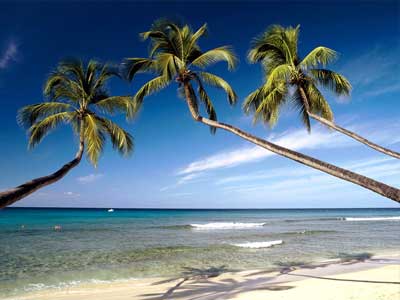 spiral columns, and by the huge, gaudy statue of Ignatius Loyola, the founder of the Jesuit order. To the right of the altar is the Basilica’s big attraction the silver casket enshrining the mummified remains of St Francis Xavier, Goa’s patron saint, who spent his life spreading Christianity among the Portuguese colonies. Murals of events from the saint’s life run round the walls of the Italian-marble sarcophagus enclosing the casket. One of the most well-travelled corpses in history, Xavier was taken all over the place after his death in China in 1552, and only came to rest here in 1613. During his posthumous travels, one of his toes was bitten off by a Portuguese holy-relic hunter (1554). Later, as the grisly process of dismemberment continued, he lost a hand to the Japanese Jesuits (1619), had various sections of intestine removed, and suffered a broken neck after being stuffed in an undersized grave. Today, what’s left of his corpse is remarkably well preserved. If you don’t believe it, you can peer at Xavier’s bald, mottled head—illuminated within the casket by a naked bulb—or, for a donation, view his silver-encased toes. Every 10 years, the shrivelled cadaver is given a public veneration (the next occasion will be 1994) and the town becomes a stadium of hysterical devotees. The same thing happens, to a lesser extent, at the annual
spiral columns, and by the huge, gaudy statue of Ignatius Loyola, the founder of the Jesuit order. To the right of the altar is the Basilica’s big attraction the silver casket enshrining the mummified remains of St Francis Xavier, Goa’s patron saint, who spent his life spreading Christianity among the Portuguese colonies. Murals of events from the saint’s life run round the walls of the Italian-marble sarcophagus enclosing the casket. One of the most well-travelled corpses in history, Xavier was taken all over the place after his death in China in 1552, and only came to rest here in 1613. During his posthumous travels, one of his toes was bitten off by a Portuguese holy-relic hunter (1554). Later, as the grisly process of dismemberment continued, he lost a hand to the Japanese Jesuits (1619), had various sections of intestine removed, and suffered a broken neck after being stuffed in an undersized grave. Today, what’s left of his corpse is remarkably well preserved. If you don’t believe it, you can peer at Xavier’s bald, mottled head—illuminated within the casket by a naked bulb—or, for a donation, view his silver-encased toes. Every 10 years, the shrivelled cadaver is given a public veneration (the next occasion will be 1994) and the town becomes a stadium of hysterical devotees. The same thing happens, to a lesser extent, at the annual 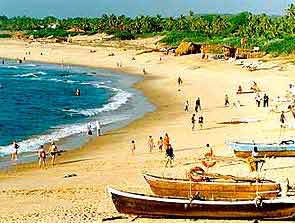 celebration on 3 December of the saint’s death. Behind the casket, steps lead up to a small museum housing various portraits and relics attributed to Xavier, his life and times. The Basilica is open 9 am-6.30 pm daily; Mass at 7 am and 8 am weekdays, 8 am and 9.15 am Sunday. No photography is allowed.
celebration on 3 December of the saint’s death. Behind the casket, steps lead up to a small museum housing various portraits and relics attributed to Xavier, his life and times. The Basilica is open 9 am-6.30 pm daily; Mass at 7 am and 8 am weekdays, 8 am and 9.15 am Sunday. No photography is allowed.
Across the road is the huge Se Cathedral (1562-1652). Dedicated to St Catherine of Alexandria, a pagan girl who embraced Christianity and was beheaded on the same date (25 November) that the Portuguese took Old Goa from the Muslims, it is one of Asia’s largest churches, having 15 altars. The harmony of its façade was destroyed in 1776, when lightning demolished one of its twin bell towers. The remaining tower houses the famous ‘Golden Bell’ which once announced the Beath – , knell of burning heretics during the Inquisition, and now sounds over a deserted city (three times a day: 5.30 am, 12.30 pm, 6.30 pm) to a distance of 10 km (6 1/2 miles). Walking up the crumbling staircase to view it is highly unsafe. The grand Renaissance Cathedral within is built in the Portuguese-Gothic style—the Corinthian interior being a baroque riot of carvings, with a vast barrel-vault  ceiling and a glittering, gilded main altar (featuring painted scenes from the short life of St Catherine) which is the finest of India. Look at the ‘miraculous’ stone cross in one of the 14 side-chapels. According to the guide, it ‘grew’ so high over the centuries that the ceiling had to be raised. Nowadays it’s protected by a sturdy wooden support to stop holy-relic hunters chipping away souvenirs. Undeterred, they chip away at the wood surround instead.
ceiling and a glittering, gilded main altar (featuring painted scenes from the short life of St Catherine) which is the finest of India. Look at the ‘miraculous’ stone cross in one of the 14 side-chapels. According to the guide, it ‘grew’ so high over the centuries that the ceiling had to be raised. Nowadays it’s protected by a sturdy wooden support to stop holy-relic hunters chipping away souvenirs. Undeterred, they chip away at the wood surround instead.
The nearby Convent and Church of St Francis of Assisi, notable for its two-storey in ncade crowned with twin octagonal towers, is one of Old Goa’s most fascinating buildings . Originally a small Franciscan chapel (commenced 1517), the present tructure was constructed in 1661. It is notable for its richly carved woodwork, ancient murals, and flooring of 16th-century gravestones. The Archaeological Museum to the rear (open 10 am-5 pm, except Friday; entrance free) has a model Portuguese caravelle (poorly lit), an entertaining gallery of ex-Portuguese viceroys, and sculptures from the Hindu temples recovered from Goan sites.
If you want to make a day of it at Old Goa, leave the tour at this point. There’s no problem getting back to Panjim: buses run back there every 20 minutes or so (15-20-minute journey). When you’ve had enough of dusty old churches, it’s time to visit Diwar Island. This is a wonderful little demi-paradise, with empty beaches, shady palm bowers, and rustic old Portuguese houses. To get there, walk down the road behind Se Cathedral to the pier, catch a ferry (regular service) over the Mandovi River, and hop on the connecting bus into the island interior. A short, strenuous climb takes you up to the top of the island, with memorable views from the church. Return down for a relaxing afternoon on the beach. Don’t forget to bring a packed lunch.
back to Panjim: buses run back there every 20 minutes or so (15-20-minute journey). When you’ve had enough of dusty old churches, it’s time to visit Diwar Island. This is a wonderful little demi-paradise, with empty beaches, shady palm bowers, and rustic old Portuguese houses. To get there, walk down the road behind Se Cathedral to the pier, catch a ferry (regular service) over the Mandovi River, and hop on the connecting bus into the island interior. A short, strenuous climb takes you up to the top of the island, with memorable views from the church. Return down for a relaxing afternoon on the beach. Don’t forget to bring a packed lunch.
Staying on the tour, you’ll continue on to the Ponda district, to see the 15th-century Shri Mangesh Temple, one of the few Hindu shrines in Goa to survive Muslim and Portuguese iconoclasm. Attractively situated on a hillock surrounded by green hills, it’s a simple yet elegant structure dedicated to Shiva. The temple musicians here are astonishingly good. Set in an open courtyard, the shrine is notable for its glass chandeliers and blue-china murals. At nearby Mardol, you’ll see the Shri Mahalsa Temple, one of Goa’s oldest temples, dedicated to Vishnu. It was shifted here from its original site when Muslim persecution threatened its survival. You may also see the Shanta Durga Temple at Kavlem, with its impressive idol of the Goddess of Peace (Shanta Durga) flanked by Vishnu and Shiva.
open courtyard, the shrine is notable for its glass chandeliers and blue-china murals. At nearby Mardol, you’ll see the Shri Mahalsa Temple, one of Goa’s oldest temples, dedicated to Vishnu. It was shifted here from its original site when Muslim persecution threatened its survival. You may also see the Shanta Durga Temple at Kavlem, with its impressive idol of the Goddess of Peace (Shanta Durga) flanked by Vishnu and Shiva.
Lunch is taken at Margao, Goa’s southern centre and a thriving commercial metropolis. It has parks, modern buildings, and a very Latin flavour. Here are some of the area’s most beautiful old Portuguese mansions, with balconies, patios, terraces and red-tiled sloping roofs—still lived in by descendants of the families who built them 400 years ago. There is not much for the tourist here—most folk just pass through on their way to Cola Beach. But if you get stuck here (on your way in from the south by train, perhaps) stay at the cheap and pleasant Tourist Hostel (tel 22513) at the top of the main square, with rooms from Rs55. It has a clean, adequate restaurant. Another hotel is the Goa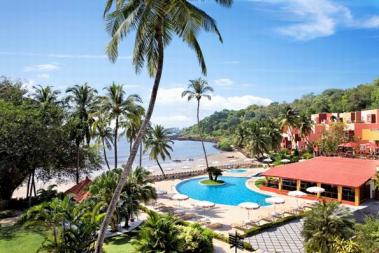 Woodlands (tel 21121) opposite the bus-stand on Miguel Loyola Furtado Road, with rooms from Rs250 /300. Casa Menino and Longhino’s, opposite the Municipality building are both excellent for Goan food. Gaylin is one of Goa’s best Chinese restaurants. Margao’s tourist office is in the Municipal Building. To get here from the airport, get a bus to Vasco, then another into Margao (total journey time 1-1 1/2 hrs). Regular buses to Benaulim (5 km: 3 miles) and Colva (10 km: 61/2 miles) from Margao.
Woodlands (tel 21121) opposite the bus-stand on Miguel Loyola Furtado Road, with rooms from Rs250 /300. Casa Menino and Longhino’s, opposite the Municipality building are both excellent for Goan food. Gaylin is one of Goa’s best Chinese restaurants. Margao’s tourist office is in the Municipal Building. To get here from the airport, get a bus to Vasco, then another into Margao (total journey time 1-1 1/2 hrs). Regular buses to Benaulim (5 km: 3 miles) and Colva (10 km: 61/2 miles) from Margao.
A pleasant hour at Colva Beach is followed by a visit to Marmagao, one of India’s finest natural harbours. Here you can see mountains of iron ore (crushed from the cliff directly over the harbour), and fleets of tankers loading up 1000 tons of crude oil per hour. Located close to busy, modern Vasco da Gama (the airport gateway to Goa), tourists are shown Marmagao’s massive refinery and shipping port, ostensibly for its fine views over the surrounding coastline, but more (one suspects) to demonstrate the new-found industrial muscle of this previously poor, agricultural territory.
If you’re not into such propaganda, leave the tour at Colva and spend an altogether more enjoyable afternoon on the beach.

